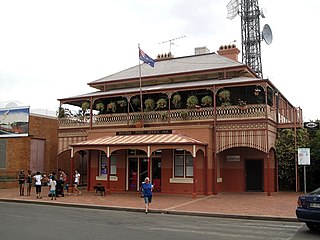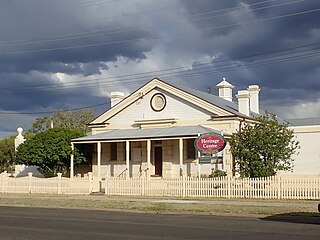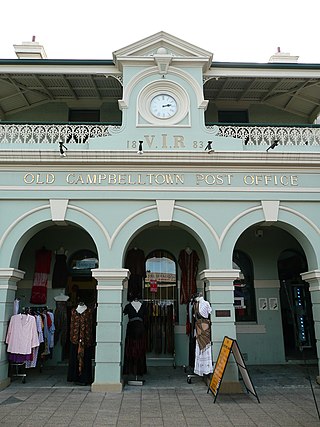
Corowa is a town in the state of New South Wales in Australia. It is on the bank of the Murray River, the border between New South Wales and Victoria, opposite the Victorian town of Wahgunyah. It is the largest town in the Federation Council and was the administrative centre of the former Corowa Shire. The name could have derived from an Aboriginal word referring to the curra pine which yielded gum used by Aboriginal people to fasten the heads of spears to the shafts. Another translation is "rocky river".

Maryborough Courthouse is a heritage-listed courthouse at 170 Richmond Street, Maryborough, Fraser Coast Region, Queensland, Australia. It was designed by Francis Drummond Greville Stanley and built in 1877 by John Thomas Annear for the Queensland Government. It is also known as Maryborough Court House and Government Offices. It was added to the Queensland Heritage Register on 21 October 1992.

The Justice and Police Museum is a heritage-listed former water police station, offices and courthouse and now justice and police museum located at 4-8 Phillip Street on the corner of Albert Street, in the Sydney central business district in the City of Sydney local government area of New South Wales, Australia. It was designed by Edmund Blacket, Alexander Dawson and James Barnet and built from 1854 to 1886. It is also known as Police Station & Law Courts (former) and Traffic Court. The property is owned by the Department of Justice, a department of the Government of New South Wales. It was added to the New South Wales State Heritage Register on 2 April 1999.

The Central Local Court House or Police Law Courts or Central Police Court is a heritage-listed building located at 98 Liverpool Street, in the central business district of Sydney, New South Wales in Australia. Constructed in the Federation Free Classical style based on original designs by Colonial Architect, James Barnet, the building structure was completed in 1892 under the supervision of Barnet's successor, Government Architect, Walter Liberty Vernon. It is also known as Sydney Central Local Court House, Police Law Courts and Central Police Court. The property is owned by the Department of Justice, a department of the Government of New South Wales. It was added to the New South Wales State Heritage Register on 2 April 1999. The court house is located in a precinct that includes the Downing Centre, and buildings housing the Family Court of Australia and the Federal Circuit Court in Sydney. Adjacent to the court house is Brickfield Place, a brick paved courtyard with seating and planter boxes, constructed in 1892, assessed as a good example of urban design for public open space.

Bathurst Courthouse is a heritage-listed courthouse at Russell Street, Bathurst, in the Central West region of New South Wales, Australia. Constructed in the Federation Free Classical style based on original designs by Colonial Architect, James Barnet, the building structure was completed in 1880 under the supervision of Barnet's successor, Government Architect, Walter Liberty Vernon. The property is owned by Attorney General's Department. It was added to the New South Wales State Heritage Register on 2 April 1999.

The Wellington Post Office is a heritage-listed post office located at 21 Maughan Street, Wellington in the Dubbo Regional Council local government area of New South Wales, Australia. It was designed by Colonial Architect’s Office, under the direction of James Barnet, and built between 1869 and 1904. The property, which is owned by Australia Post, was added to the New South Wales State Heritage Register on 22 December 2000.

Bourke Post Office is a heritage-listed post office at 47 Oxley Street, Bourke, in the Orana region of New South Wales, Australia. It was designed by the Colonial Architect's Office under James Barnet and built in 1880 by E. Heseler. It is also known as Bourke Post and Telegraph Office. The property is owned by the Keane Family Trust. It was added to the New South Wales State Heritage Register on 23 June 2000.

Broken Hill Post Office is a heritage-listed post office at 258–260 Argent Street, Broken Hill, in the Far West of New South Wales, Australia. The original building was designed by James Barnet, and was built from 1890 to 1892 by John Dobbie. Walter Liberty Vernon designed a telegraph office addition in 1900. The property is owned by Australia Post. It was added to the New South Wales State Heritage Register on 22 December 2000. It was added to the Australian Commonwealth Heritage List on 08 November 2011.

The Corowa Flour Mill is a heritage-listed former flour mill and now tourist attraction at Steel Street, Corowa, Federation Council, New South Wales, Australia. It is also known as the Corowa Flour Mill and site. It was added to the New South Wales State Heritage Register on 2 April 1999.

The Corowa railway station is a heritage-listed railway station located on the Culcairn-Corowa line at Corowa, in the Federation Council local government area of New South Wales, Australia. It is also known as Corowa Railway Station and yard group. The property was added to the New South Wales State Heritage Register on 2 April 1999.
The Bundarra Police Station and Courthouse is a heritage-listed former police station and courthouse located at Oliver Street, Bundarra, in the New England region of New South Wales, Australia. It was designed by James Barnet and built from 1869 to 1870 by Alfred Doorey. The property is owned by Bundarra Community Purposes Reserve Trust. It was added to the New South Wales State Heritage Register on 2 April 1999.

The Narrabri Gaol and Residence is a heritage-listed former gaol and now museum at Bowen Street, Narrabri, Narrabri Shire, New South Wales, Australia. The building was designed by James Barnet and built from 1880 to 1881 by J. Conlon. The property is owned by Narrabri Shire Council and was added to the New South Wales State Heritage Register on 2 April 1999.

Wingham Post Office is a heritage-listed post office at Wynter Street, Wingham, Mid-Coast Council, New South Wales, Australia. The original building was designed by the Colonial Architect's Office under James Barnet and constructed by William T. Smith of Cundletown. Additions were designed by the CAO under Barnet's successor, Walter Liberty Vernon, and built by S. A. Levick (1904) and H. W. Alcorn. The property is owned by Australia Post. It was added to the New South Wales State Heritage Register on 22 December 2000.
Casino Post Office is a heritage-listed post office at 102 Barker Street, Casino, in the Northern Rivers region of New South Wales, Australia. It was designed by the NSW Colonial Architect's Office and built from 1879. The property is owned by Australia Post. It was added to the New South Wales State Heritage Register on 23 June 2000.

Old Port Macquarie Courthouse is a heritage-listed former courthouse and now justice museum at Clarence Street (cnr), Port Macquarie, Port Macquarie-Hastings Council, New South Wales, Australia. It was designed by James Barnet and built in 1869 by Butler and Bourne. It was added to the New South Wales State Heritage Register on 2 April 1999.

The Greenway Wing of the Supreme Court of New South Wales is a heritage-listed courthouse located at the junction of King and Elizabeth Streets, in the Sydney central business district, in the City of Sydney local government area of New South Wales, Australia. It was designed by Francis Greenway, Standish Lawrence Harris, and James Barnet and built from 1820 to 1828. It is also known as Sydney Supreme Court House (Old Court House) and Old Court House. The property is owned by the Department of Justice and Attorney General, departments of the Government of New South Wales. It was added to the New South Wales State Heritage Register on 2 April 1999.

Richmond Post Office is a heritage-listed former post office at 286 Windsor Street, Richmond, City of Hawkesbury, New South Wales, Australia. It was designed by Colonial Architect James Barnet and built from 1875 to 1888. The original building was built by a Mr. Johnson, with the second-story addition in 1888 added by Samuel Bought. It is also known as Richmond Telegraph and Post Office. It was added to the New South Wales State Heritage Register on 23 June 2000.

The Campbelltown Post Office is a heritage-listed former post office and now shops and office space at 261 Queen Street, Campbelltown, New South Wales, a suburb of Sydney, Australia. It was designed by James Barnet and built in 1881. It is also known as Campbelltown Post Office (former). The property is privately owned. It was added to the New South Wales State Heritage Register on 2 April 1999.

Windsor Court House is a heritage-listed courthouse at Court and Pitt Streets, Windsor, City of Hawkesbury, New South Wales, Australia. It was designed by Francis Greenway with a later extension by James Barnet and built from 1821 to 1822 by William Cox. It was added to the New South Wales State Heritage Register on 2 April 1999.

The Old Police Station, The Rocks is a heritage-listed former police station and now home to Sergeant Lok, a Modern Asian restaurant and bar, that is located at 127–129 George Street in the inner city Sydney suburb of The Rocks in the City of Sydney local government area of New South Wales, Australia. It was designed by James Barnet and built in 1882 by W. Cains and Sons. The property is owned by Property NSW, an agency of the Government of New South Wales. It was added to the New South Wales State Heritage Register on 10 May 2002.



















